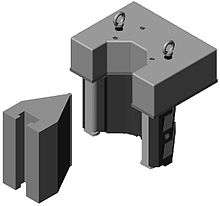Spring Back Compensation
Due to the plastic-elastic characteristic of a metal, it is typical that any deformation of sheet metal at room temperature will have both elastic and plastic deformation. After the metal work piece is removed from the tool or deformation implement, the elastic deformation will be released and only the plastic deformation will remain. When a metal forming tool is planned and designed to deform a work piece, the shape imparted by the tool will be a combination of elastic and plastic deformation. The release of the elastic deformation is the spring back often observed at the end of a metal forming process. The spring back has to be compensated to achieve an accurate result.
Usually that is realized by overbending the material correspondent to the magnitude of the spring back. That means for the practical side of the bending process, the bending former enters deeper into the bending prism.
For other sheet metal forming operations like drawing it entails deforming the sheet metal past the planned net shape of the part, so that when springback is released from the part, the plastic deformation in that part delivers the desired shape of the part. In the case of complex tools the spring back has to be already considered in the engineering and construction phases. Therefore complex software simulations are used. Frequently this is not enough to deliver the desired results. In such cases practical experiments are done, using the trial-and-error plus experience method to correct the tool. However, the results (workpieces) are only stable, if all influencing factors are the same.[1]
This mainly includes:
- Yield strength of the sheet
- Chemical composition of the sheet
- Structure of the material (e.g. direction of grain during production process)
- Wear of tools
- Material temperature
- Aging processes of the raw material (significant for aluminium and copper)
- Deformation rate
The list of factors may be continued. Springback assessment of final formed products is a difficult problem and is affected by the complexity of the formed shape. The NUMISHEET 93 conference benchmark problem involves the draw bending of a U-channel using three measured parameters. Parameterless approaches have been proposed for more complex geometries but need validation.[2]
Practical example: electronic bending tools with spring-back compensation

The electrical industry mostly uses flat materials of copper and aluminium producing equipment for the electrical industry, especially switchgear and busbar production. The properties between two different charges of those materials vary strongly, having a critical influence on the dimensions.
In the 60s, Dieter Ehrt invented the bending technology for flat material which measures each bend angle and provides spring back compensation. This gives the bend angle of flat materials true accuracy. This is attained by using bending prisms with electronic angular measurement technology. The principle is easy, but smart: While bending two flat bolds supporting the material turn around. The bolds are directly connected to the angular sensors. A computer or rather the machine control then calculates the required final stroke. The spring back of every bend is compensated regardless of material type.
If the measuring accuracy is 0.1º, a high angle accuracy of +/- 0.2º is achieved instantly with the first work piece without any rework. Because no adjustments are required, material waste amounts and setup times drop considerably. Even inconsistencies within a single piece of material are automatically adjusted.
References
- Optimierung der Produkt- und Prozessentwicklung. ETH Zürich. 1999. p. 67. ISBN 978-3728126962.
- Raghavan; et al. (September 2013). "Numerical assessment of springback for the deep drawing process by level set interpolation using shape manifolds". International Journal of Material Forming. 7 (4): 487–501. doi:10.1007/s12289-013-1145-8.
- M. Weck: Werkzeugmaschinen Maschinenarten und Anwendungsbereiche (VDI-BuchSpringer Vieweg Verlag, 6. Aufl. 2005 (2. August 2005), ISBN 3540225048
- ETH Zürich: Optimierung der Produkt- und Prozessentwicklung. vdf Hochschulvlg, 1999, ISBN 3728126969.
- EHRT: Brochure Bending machines and tools., Rheinbreitbach, 2012.